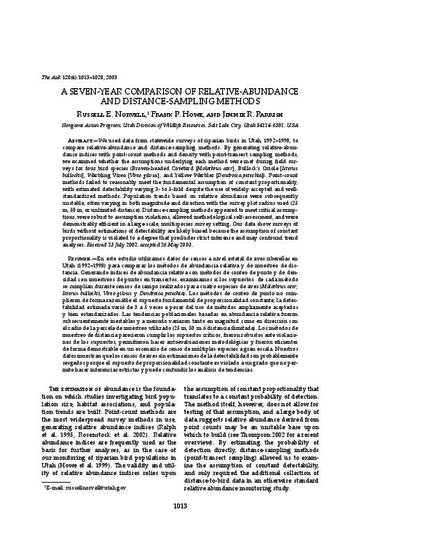
Article
Seven-Year Comparison of Relative-Abundance and Distance-Sampling Methods
The Auk
(2003)
Abstract
We used data from statewide surveys of riparian birds in Utah, 1992–1998, to compare relative-abundance and distance-sampling methods. By generating relative-abundance indices with point-count methods and density with point-transect sampling methods, we examined whether the assumptions underlying each method were met during field surveys for four bird species (Brown-headed Cowbird [Molothrus ater], Bullock's Oriole [Icterus bullockii], Warbling Vireo [Vireo gilvus], and Yellow Warbler [Dendroica petechia]). Point-count methods failed to reasonably meet the fundamental assumption of constant proportionality, with estimated detectability varying 3- to 5-fold despite the use of widely accepted and well-standardized methods. Population trends based on relative abundance were subsequently unstable, often varying in both magnitude and direction with the survey plot radius used (25 m, 50 m, or unlimited distance). Distance-sampling methods appeared to meet critical assumptions, were robust to assumption violations, allowed methodological self-assessment, and were demonstrably efficient in a large-scale, multispecies survey setting. Our data show surveys of birds without estimations of detectability are likely biased because the assumption of constant proportionality is violated to a degree that precludes strict inference and may confound trend analyses.
Disciplines
Publication Date
2003
DOI
https://doi.org/10.1093/auk/120.4.1013
Citation Information
Frank P Howe. "Seven-Year Comparison of Relative-Abundance and Distance-Sampling Methods" The Auk Vol. 120 Iss. 4 (2003) p. 1013 - 1028 Available at: http://works.bepress.com/frank_howe/10/
